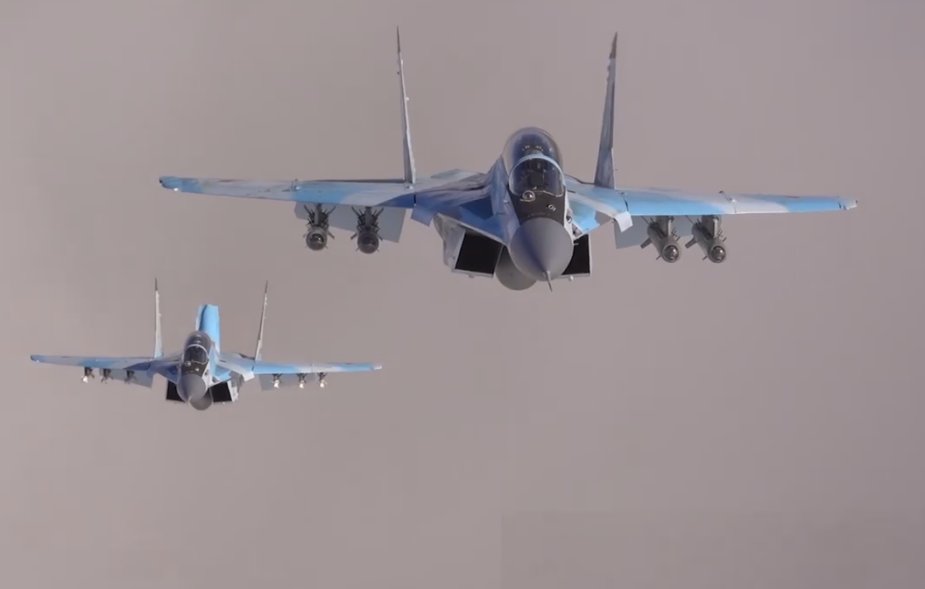Russian pilots have tested the weapons and on-board equipment of the advanced MiG-35 fighter, the Russian Defense Ministry said in a statement Wednesday.
 Russian pilots testing MiG-35 weapons and on-board equipment
Russian pilots testing MiG-35 weapons and on-board equipment
(Credit: Russian Ministry of Defense)
Pilots are testing the latest multirole MiG-35S (serial) and MiG-35UB (combat training) fighter jets in the 929th State Flight Test Center (GLITs) of the Russian Defense Ministry in Akhtubinsk, the ministry said.
"The pilots jointly with MiG Corporation experts have tested some air-to-air and air-to-surface weapons and onboard electronic equipment elements. The control system is being actively checked. The aircraft fly to check aerodynamic stability and maneuvering characteristics," it said.
MiG-35S and MiG-35UB onboard equipment confirmed effectiveness in all regimes in conditions of intensive electronic warfare.
Onboard radars successfully detected ground and air targets themselves and by outside aiming data. Specific attention was paid to the operations of weapon aiming and control systems. The onboard optical radar was tested to detect air, ground and surface targets in all flight regimes.
The flights are conducted in close to combat conditions and in a real jamming situation.
The Defense Ministry footage posted in YouTube showed MiG-35S (702 blue) and MiG-35UB (712 blue) participating in the trials.
One-seater MiG-35S took off with four smart KAB-500Kr bombs with television homing warheads carried on underwing suspensions. The jet also carried a suspended 1500-liter fuel tank under the central fuselage. At the same time it did not carry T220 suspended aiming container designed for MiG-29SMT, MiG-29M/M2, MiG-35 and Su-35S.
Two-seater MiG-35UB (designated by MiG Corporation as MiG-35D) took off with six overall B-72 mockups whose shape, size and weight corresponded to R-73 short-range guided missile. It also carried 1500-liter suspended fuel tank under the central fuselage. The footage showed four BDZ-UMK2 ejector racks under the wing.
The Defense Ministry and MiG Corporation signed a contract for a batch of MiG-35S and MiG-35UB to be delivered by 2030.
MiG-35 and its two-seater option MiG-35UB are designed to operate in intensive combat and multi-layered air defense. They destroy air, moving and stationary ground and surface targets in any climate and weather. The two-seater can be used as a training aircraft. The construction is borrowed from multirole shipborne MiG-29K/KUB and MiG-29M/M2. It is distinguished by a bigger payload on nine suspensions, increased fuel reserve, air refueling possibility and a possibility to use the jet as a tanker. The glider is corrosion resistant. MiG-35 has a decreased signature. Normal takeoff weight is 19200 kg, MiG-35D - 19000 kg, maximum takeoff weight is 24500 kg for both options.
Maximum altitude speed is 2100 km/h and 1400 km/h at the ground. Practical ceiling is 16000 meters. One-seater MiG-35 with air-to-air missiles and three suspended fuel tanks has a radius of 1000-1400 km depending on the arms and flight altitude. Two-seater MiG-35D with air-to-air missiles and three suspended fuel tanks has a range of 900-1300 km, with air-to-surface missiles and three fuel tanks - 750-1050 km. Maximum overload for both options is 9G.
The onboard radar detects and tracks 10-30 targets at a distance of 160 km and allows simultaneously destroying up to six air and four ground targets.
















